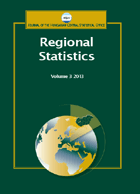Spatial econometrics: transport infrastructure
development and real estate values in Budapest
Spatial econometrics: transport infrastructure
development and real estate values in Budapest
Author(s): Attila Béres, György Jablonszky, Tamás Laposa, Györgyi NyikosSubject(s): Social Sciences, Economy, Geography, Regional studies
Published by: Központi Statisztikai Hivatal
Keywords: public infrastructures; urban transportation analysis; sustainability
Summary/Abstract: Over the last few decades, the M4 metro line has been the largest transport infrastructure project in Budapest. Despite the size and importance of the project, there has been no evaluation of its economic impacts in the scientific literature. This paper addresses this gap and expands the scientific discourse on spatial econometrics, cohesion policy, and sustainable urban development by exploring the impact of the new metro line on real estate prices. To assess the economic effect of the M4 project on the value of nearby properties, the authors use counterfactual impact evaluation along with a measurement of the utility increase in the change in property prices. The research database has been provided by the National Tax and Customs Administration. Sustainable and useful public infrastructure de-velopments will have a positive effect on the value of nearby properties. It is reasonable to assume that easier access to downtown areas can be an added value; however, the increased traffic, crowds, or noise may outweigh these positive impacts. In case of M4, the authors find no significant effects of the stations on the Pest side. Only the new stations that were not connected directly to existing underground lines exert apositive effect on nearby real estate properties. It is worth using this information when making decisions on further transport development in Budapest. This paper presents original research on the economic effects of the M4 transport project. It determines the factors that increase or decrease the economic effects of the stations. As has been shown, several stations have failed to generate additional economic value. This information is highly useful for the planning of future transport infrastructure projects.
Journal: Regional Statistics
- Issue Year: 9/2019
- Issue No: 02
- Page Range: 89-104
- Page Count: 16
- Language: English

